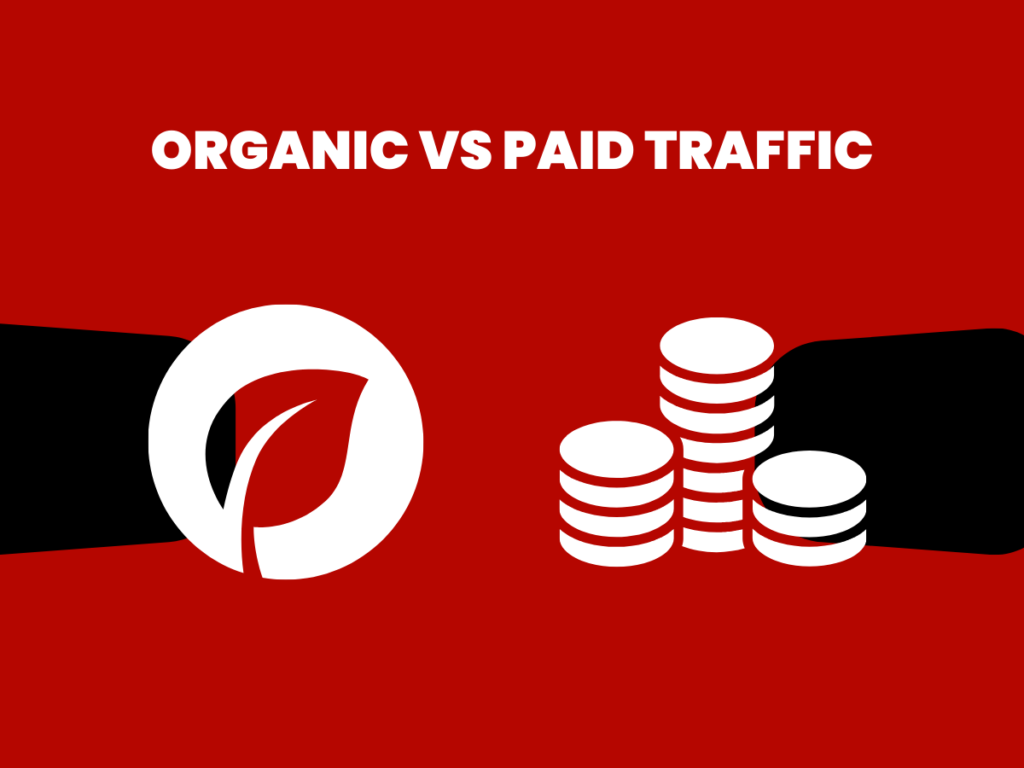Organic traffic comes from unpaid sources, like search engines and social media. Increasing organic traffic is primarily done through SEO, which involves strategies such as keyword optimisation, link building, and UX improvements. Paid traffic requires advertising spend and comes from sources such as paid search, social media ads and display ads.
Increasing organic traffic is generally more cost-effective but takes longer to achieve. Paid traffic, on the other hand, offers more accurate targeting and the potential for immediate results, but requires more nursing and a higher upfront cost.
While everyone’s discussing the latest marketing trends and technological innovations, it can be important not to lose sight of the basics. So in our latest blog post, we’re taking it back to digital marketing 101 by comparing organic traffic with paid traffic. We’ll outline the difference between organic and paid traffic, how you can increase each channel and which option is best suited to your business.
What Is The Difference Between Organic Traffic and Paid Traffic?
The difference between organic traffic and paid traffic comes down to one thing: cost. Organic traffic comes from channels that are unpaid, and paid traffic comes from channels that require payment. Paid traffic involves advertisements, in the form of PPC ads and social media ads. Organic traffic, on the other hand, is generated from channels such as search engines and organic social.
How To Increase Organic Traffic
SEO
When people talk about organic traffic, the most obvious channel is organic search. This is traffic that comes from organic listings on Google’s search results. Note, this doesn’t include traffic from ad listings as these are paid for. Increasing traffic from organic search relies on increasing visibility in search engine results, which is achieved through optimising websites for search engine algorithms.
To appear higher in search engine results, you’ll need to consider keywords, backlinks, user experience and more technical aspects of SEO known as off-page SEO.
Organic Social
The other way to increase traffic without paying is through your social media pages. Again, while this can be achieved through paid ads, organic social traffic only refers to traffic that is generated from unpaid posts. To increase organic social traffic, the solution likely lies in the content you produce.
Today, social media algorithms generally favour video content, especially video content that is shareable. The key to creating shareable video content lies in producing professional-looking content that appeals to your target audience.
How To Increase Paid Traffic
PPC
PPC, or pay-per-click traffic, refers to traffic that is generated by digital advertisements whereby the advertiser pays a fee every time their ad is clicked. These can appear in various places across the web in various formats.
Paid Search
You will probably have noticed that the top results on search engine results pages are labelled ‘sponsored’, traffic from this channel would be attributed to paid search. For ecom-based queries, results pages will usually contain sponsored product listings at the top of the page.
Paid Social
You’ll also notice that when browsing social media platforms, your activity is regularly interrupted by advertisements. This could be in the form of Instagram stories, TikTok ads, sponsored Facebook posts and so on.
Display Ads
Display ads are the OG of the PPC world, and you’ll find them on any website or application that is part of Google’s vast network. Early display ads existed as banners at the top of websites, and while they still exist today, display ads can also appear in video form, on mobile devices and even on Google properties like Gmail and Google Maps.
Despite Wordstream estimating that ads on the Google Display Network carry a conversion rate of less than 1% (compared to the search network’s 4.40% conversion rate), display ads can still be an effective way to reach a wide audience and stay in the minds of potential customers.
Organic Traffic vs Paid Traffic: Which Is Best?
When deciding between organic traffic and paid traffic, there’s no right or wrong answer. It ultimately depends on a range of factors, including your industry, audience, goals, budget and how long you are prepared to wait to see results.
Pros of organic traffic
- Offers high ROI as traffic is free
- High organic visibility generates trust
- Generally has high conversion rates as users are actively searching for your product/service
Cons of organic traffic
- Requires a long-term commitment
- Algorithm updates can cause results to fluctuate
- Organic search results outside of the first 3 results have a click-through rate of less than 10%
Pros of paid traffic
- Quicker ROI as ads can appear in front of users instantly
- Users can be targeted by certain demographics or retargeted based on previous interactions with the brand
- Can increase brand awareness even if users don’t click the ad
Cons of paid traffic
- Requires a large upfront investment
- Ads need to be constantly updated in line with new products/offers
- Ads can be seen as disruptive, which may create a negative perception of the brand
Final Thoughts
The biggest difference between organic versus paid traffic is cost, but other differences include approach and value. Paid traffic offers immediate visibility but demands ongoing investment and constant optimisation. Organic traffic, while technically free, requires more time.
Investing in SEO can deliver excellent ROI, but only when done thoroughly. Many businesses’ SEO efforts fail when content is published without any strategy or when keywords are chased without any research. As already pointed out, if your efforts aren’t enough to land in the top three results, it could be a complete waste of resources. On the other hand, paid campaigns can get you in front of your audience fast, but this doesn’t guarantee a return on your investment.
If you want to see how we’ve increased both organic and paid traffic for our clients, head to our case studies page and contact us today if you’re looking to achieve similar results.
